AKG Acoustics US HT400 Handheld Transmitter User Manual BDA WMS 400 DE
AKG Acoustics US Handheld Transmitter BDA WMS 400 DE
Users Manual

Bedienungsanleitung. . . . . . . . . . . . . . . S. 2
Bitte vor Inbetriebnahme des Gerätes lesen!
User Instructions. . . . . . . . . . . . . . . . . p. 18
Please read the manual before using the equipment!
WMS 400
wireless microphone system

1Safety and Environment . . . . . . . . . . . . . . . . . . . . . . . . . . . . . . . . . . . . . . . . . . . . . . . . 19
1.1 Safety .. . . . . . . . . . . . . . . . . . . . . . . . . . . . . . . . . . . . . . . . . . . . . . . . . . . . . . . . . . . 19
1.2 Environment . . . . . . . . . . . . . . . . . . . . . . . . . . . . . . . . . . . . . . . . . . . . . . . . . . . . . . . 19
2Description. . . . . . . . . . . . . . . . . . . . . . . . . . . . . . . . . . . . . . . . . . . . . . . . . . . . . . . . . . . 19
2.1 Introduction . . . . . . . . . . . . . . . . . . . . . . . . . . . . . . . . . . . . . . . . . . . . . . . . . . . . . . . 19
2.2 Unpacking . . . . . . . . . . . . . . . . . . . . . . . . . . . . . . . . . . . . . . . . . . . . . . . . . . . . . . . . 19
2.3 Optional Accessories . . . . . . . . . . . . . . . . . . . . . . . . . . . . . . . . . . . . . . . . . . . . . . . . 20
2.4 WMS 400 . . . . . . . . . . . . . . . . . . . . . . . . . . . . . . . . . . . . . . . . . . . . . . . . . . . . . . . . . 20
2.5 SR 400 Receiver. . . . . . . . . . . . . . . . . . . . . . . . . . . . . . . . . . . . . . . . . . . . . . . . . . . . 20
2.6 HT 400 Handheld Transmitter . . . . . . . . . . . . . . . . . . . . . . . . . . . . . . . . . . . . . . . . . . 21
2.7 PT 400 Bodypack Transmitter. . . . . . . . . . . . . . . . . . . . . . . . . . . . . . . . . . . . . . . . . . 21
3Setting Up.. . . . . . . . . . . . . . . . . . . . . . . . . . . . . . . . . . . . . . . . . . . . . . . . . . . . . . . . . . . 22
3.1 Inserting the Transmitter Battery . . . . . . . . . . . . . . . . . . . . . . . . . . . . . . . . . . . . . . . . 22
3.2 Positioning the Receiver . . . . . . . . . . . . . . . . . . . . . . . . . . . . . . . . . . . . . . . . . . . . . . 22
3.3 Rack Mounting . . . . . . . . . . . . . . . . . . . . . . . . . . . . . . . . . . . . . . . . . . . . . . . . . . . . . 22
3.3.1 Single Receiver . . . . . . . . . . . . . . . . . . . . . . . . . . . . . . . . . . . . . . . . . . . . . . . . 22
3.3.2 Two Receivers Side by Side. . . . . . . . . . . . . . . . . . . . . . . . . . . . . . . . . . . . . . . 22
3.4 Connecting the Receiver to a Mixer . . . . . . . . . . . . . . . . . . . . . . . . . . . . . . . . . . . . . 22
3.5 Connecting the Receiver to Power . . . . . . . . . . . . . . . . . . . . . . . . . . . . . . . . . . . . . . 22
3.6 Powering Up the Receiver . . . . . . . . . . . . . . . . . . . . . . . . . . . . . . . . . . . . . . . . . . . . 22
3.7 LOCK Mode . . . . . . . . . . . . . . . . . . . . . . . . . . . . . . . . . . . . . . . . . . . . . . . . . . . . . . . 23
3.8 Setting Up the Receiver (SETUP Mode) . . . . . . . . . . . . . . . . . . . . . . . . . . . . . . . . . . 23
3.8.1 Setting the Frequency Group (Auto Group Setup) . . . . . . . . . . . . . . . . . . . . . . 24
3.8.2 Setting Frequencies for Multichannel Systems (Auto Channel Setup) . . . . . . . . 24
3.8.3 Selecting Frequencies from the Preset Screen . . . . . . . . . . . . . . . . . . . . . . . . . 25
3.8.4 Editing the Receiver Name. . . . . . . . . . . . . . . . . . . . . . . . . . . . . . . . . . . . . . . . 25
3.9 Setting Up the Transmitter . . . . . . . . . . . . . . . . . . . . . . . . . . . . . . . . . . . . . . . . . . . . 25
3.9.1 Frequency . . . . . . . . . . . . . . . . . . . . . . . . . . . . . . . . . . . . . . . . . . . . . . . . . . . . 25
3.9.2 Handheld Transmitter Input Gain . . . . . . . . . . . . . . . . . . . . . . . . . . . . . . . . . . . 26
3.9.3
Bodypack Transmitter: Connecting a Microphone/Instrument and Setting Input Gain
. . 26
3.10 Before the Soundcheck . . . . . . . . . . . . . . . . . . . . . . . . . . . . . . . . . . . . . . . . . . . . . . 27
3.10.1 Finding Dead Spots . . . . . . . . . . . . . . . . . . . . . . . . . . . . . . . . . . . . . . . . . . . . 27
3.10.2 Setting the Squelch Threshold . . . . . . . . . . . . . . . . . . . . . . . . . . . . . . . . . . . . 28
3.11 Multichannel Systems. . . . . . . . . . . . . . . . . . . . . . . . . . . . . . . . . . . . . . . . . . . . . . . . 28
4Operating Notes. . . . . . . . . . . . . . . . . . . . . . . . . . . . . . . . . . . . . . . . . . . . . . . . . . . . . . . 28
4.1 SR 400 Receiver. . . . . . . . . . . . . . . . . . . . . . . . . . . . . . . . . . . . . . . . . . . . . . . . . . . . 28
4.1.1 Selecting Modes . . . . . . . . . . . . . . . . . . . . . . . . . . . . . . . . . . . . . . . . . . . . . . . 28
4.1.2 Selecting Screens . . . . . . . . . . . . . . . . . . . . . . . . . . . . . . . . . . . . . . . . . . . . . . 28
4.1.3 Extra Functions . . . . . . . . . . . . . . . . . . . . . . . . . . . . . . . . . . . . . . . . . . . . . . . . 29
4.2 HT 400 Handheld Transmitter . . . . . . . . . . . . . . . . . . . . . . . . . . . . . . . . . . . . . . . . . . 30
4.2.1 Muting the Microphone . . . . . . . . . . . . . . . . . . . . . . . . . . . . . . . . . . . . . . . . . . 30
4.2.2 Microphone Technique. . . . . . . . . . . . . . . . . . . . . . . . . . . . . . . . . . . . . . . . . . . 30
4.3 PT 400 Bodypack Transmitter. . . . . . . . . . . . . . . . . . . . . . . . . . . . . . . . . . . . . . . . . . 30
4.3.1 Muting the Microphone . . . . . . . . . . . . . . . . . . . . . . . . . . . . . . . . . . . . . . . . . . 30
4.3.2 Locking the ON-MUTE/PRG-OFF Switch . . . . . . . . . . . . . . . . . . . . . . . . . . . . . 31
4.3.3 Microphone Technique. . . . . . . . . . . . . . . . . . . . . . . . . . . . . . . . . . . . . . . . . . . 31
5Cleaning..... . . . . . . . . . . . . . . . . . . . . . . . . . . . . . . . . . . . . . . . . . . . . . . . . . . . . . . . . . . 31
6Troubleshooting . . . . . . . . . . . . . . . . . . . . . . . . . . . . . . . . . . . . . . . . . . . . . . . . . . . . . . . 32
7Specifications . . . . . . . . . . . . . . . . . . . . . . . . . . . . . . . . . . . . . . . . . . . . . . . . . . . . . . . . 33
18
WMS 400
Table of Contents
FCC Statement
This equipment has been tested and found to comply with the limits for a Class B digital device, pursuant to Parts 74,
15, and 90 of the FCC Rules. These limits are designed to provide reasonable protection against harmful interference in
a residential installation. This equipment generates, uses, and can radiate radio frequency energy and, if not installed and
used in accordance with the instructions, may cause harmful interference to radio communications. However, there is no
guarantee that interference will not occur in a particular installation. If this equipment does cause harmful interference to
radio or television reception, which can be determined by turning the equipment off and on, the user is encouraged to
try to correct the interference by one or more of the following measures:
•Reorient or relocate the receiving antenna.
•Increase the separation between the equipment and the receiver.
•Connect the equipment into an outlet on a circuit different from that to which the receiver is connected.
•Consult the dealer or an experienced radio/TV technician for help.
Shielded cables and I/O cords must be used for this equipment to comply with the relevant FCC regulations.
Changes or modifications not expressly approved in writing by AKG Acoustics may void the user’s authority to oper-
ate this equipment.
This device complies with Part 15 of the FCC Rules. Operation is subject to the following two conditions: (1) this
device may not cause harmful interference, and (2) this device must accept any interference received, including inter-
ference that may cause undesired operation.
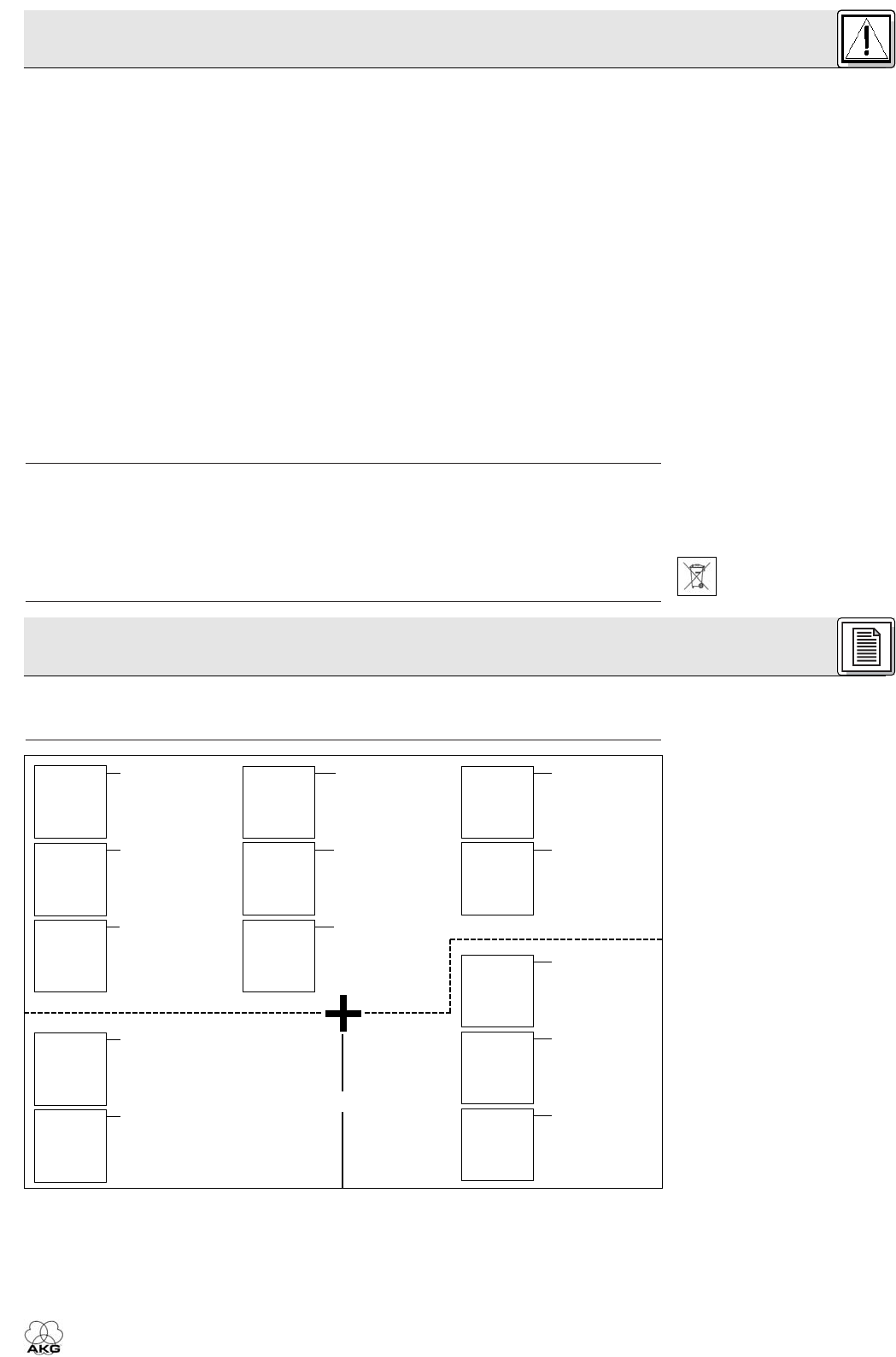
1.1 Safety
1.2 Environment
2.1 Introduction
2.2 Unpacking
Check that the packaging contains
all of the components listed above.
Should anything be missing, please
contact your AKG dealer.
1. Do not spill any liquids on the equipment and do not drop any objects through the ventilation slots in
the equipment.
2. The equipment may be used in dry rooms only.
3. The equipment may be opened, serviced, and repaired by authorized personnel only. The equipment
contains no user-serviceable parts.
4. Before connecting the equipment to power, check that the AC mains voltage stated on the supplied
power supply is identical to the AC mains voltage available where you will use the equipment.
5. Operate the equipment with the included power supply with an output voltage of 12 VDC only. Using
adapters with an AC output and/or a different output voltage may cause serious damage to the unit.
6. If any solid object or liquid penetrates into the equipment, shut down the sound system immediately.
Disconnect the power supply from the power outlet immediately and have the equipment checked by
AKG service personnel.
7. If you will not use the equipment for a long period of time, disconnect the power supply from the
power outlet. Please note that the equipment will not be fully isolated from power when you set the
power switch to OFF.
8. Do not place the equipment near heat sources such as radiators, heating ducts, or amplifiers, etc. and
do not expose it to direct sunlight, excessive dust, moisture, rain, mechanical vibrations, or shock.
9. To avoid hum or interference, route all audio lines, particularly those connected to the microphone
inputs, away from power lines of any type. If you use cable ducts, be sure to use separate ducts for
the audio lines.
10.Clean the equipment with a moistened (not wet) cloth only. Be sure to disconnect the power supply
from the power outlet before cleaning the equipment! Never use caustic or scouring cleaners or clean-
ing agents containing alcohol or solvents since these may damage the enamel and plastic parts.
11.Use the equipment for the applications described in this manual only. AKG cannot accept any liabili-
ty for damages resulting from improper handling or misuse.
1. The power supply will draw a small amount of current even when the equipment is switched off. To
save energy, disconnect the power supply from the power outlet if you will leave the equipment
unused for a long period of time.
2. When scrapping the equipment, separate the case, circuit boards, and cables, and dispose of all com-
ponents in accordance with local waste disposal rules.
3. The packaging of the equipment is recyclabe. To dispose of the packaging, make sure to use a col-
lection/recycling system provided for that purpose and observe local legislation relating to waste dis-
posal and recycling.
Thank you for purchasing an AKG product. This Manual contains important instructions for setting up and
operating your equipment. Please take a few minutes to read the instructions below carefully before oper-
ating the equipment. Please keep the Manual for future reference. Have fun and impress your audience!
19
1 Safety and Environment
WMS 400
2 Description
•1 HT 400 hand-
held transmitter
•1 SA 63 stand
adapter
OR
•1 SR 400
receiver
•2 UHF
antennas
•1 power
supply for the
receiver (if
checked on the
packaging)
•1 RMU 4000
19" rack
mounting kit
•ID Set
•1 AA size
battery for the
transmitter
•CH 400 carry-
ing case
•Frequency
Tables and
Declaration of
Conformity
•1 PT 400 body-
pack transmit-
ter
•1 MKG/L
instrument
cable
•1 terminal
connector
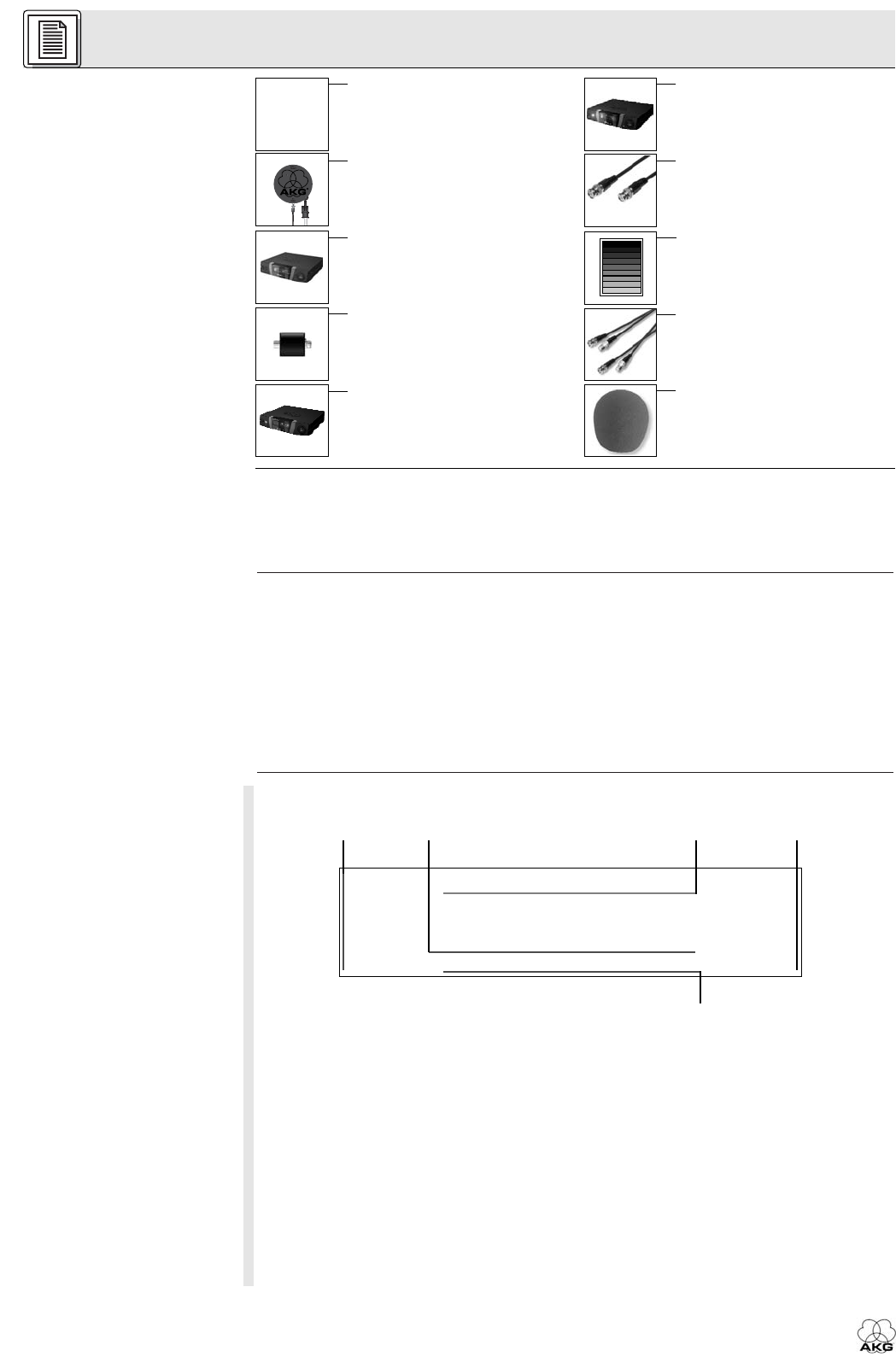
2.3 Optional Accessories
2.4 WMS 400
2.5 SR 400 Receiver
2.5.1 Controls
• Front Panel
Refer to fig. 1.
The WMS 400 wireless microphone system comprises the SR 400 stationary true diversity receiver, HT
400 handheld transmitter with a D 880 or C 900 microphone element, and the PT 400 bodypack trans-
mitter. The receiver and transmitters operate in a 30 MHz subband of the 650 MHz to 863 MHz UHF band.
You can select the receiving frequency from the preprogrammed frequency groups and subchannels of
your receiver. Both the handheld and the bodypack transmitter are set to the parameters selected on the
receiver via infrared transmission.
The receiver provides two operating modes:
In LOCK mode, all setup functions are electronically locked to prevent parameters from being readjust-
ed unintentionally during a performance or lecture. The "LOCK" label on the display indicates the receiv-
er is in LOCK mode.
SETUP mode allows you to adjust and save all receiver parameters. In SETUP mode, the "LOCK" label
disappears. An infrared transmission link tunes the handheld or bodypack transmitter to the same fre-
quency as the one you selected on the receiver. You can also set the handheld transmitter audio input
gain on the receiver and transmit the setting to the transmitter via infrared.
You can use the receiver as a standalone unit or install it in a 19" rack using the supplied RMU 4000 rack
mounting kit.
The display is protected from scratching by a transparent foil. You can peel the foil off at any time.
1POWER: Switches power to the unit on or off.
2LCD Display: The receiver provides a backlit LCD display.
The display indicates all receiver parameters:
aRF bargraph indicating the field strength of the received signal
bAlphanumeric display of the current setting
cPreset/Receiver Name, Frequency Group, Subchannel (shown in Preset and NAME screens only)
dAudio bargraph indicating the received audio level
eParameter to be adjusted, mode
If one or more warning functions are activated (see section 4.1.3), the display will be backlit in red
when a critical condition occurs. As long as all parameters are within their normal ranges, the display
is backlit in green.
3 : These three keys set the various parameters of the receiver.
•In LOCK mode:
Short push on or : scrolls through the Frequency, Preset, and receiver Name screens.
Long push on : toggles between LOCK and SETUP modes.
•In SETUP mode only:
Short push on : Calls up a parameter for adjustment or confirms a selected value.
Short push on : selects a menu item or increases a parameter value.
Short push on : selects a menu item or decreases a parameter value.
2 Description
20
WMS 400
•CU 400 charger
•SRA 1 (shown), SRA 2 B,
RA 4000 B remote antennas
•PS 4000 antenna splitter
•AB 4000 antenna booster
•HPA 4000 headphone amplifier
•PSU 4000 central power supply
•MK PS antenna cable
•Color Coding Kit
•Front panel mounting kit for
supplied antennas
•W 880 windscreen for HT 400,
remote MUTE switch for PT 400
(not shown)
acd
e
b

• Rear Panel
Refer to fig. 2.
• Audio Outputs
Refer to fig. 2.
• Bottom Panel
2.6 HT 400 Handheld
Transmitter
Refer to fig. 3.
2.7 PT 400 Bodypack
Transmitter
Refer to fig. 4.
4ID: If you use the receiver within a multichannel system, you can color-code each channel. Remove
the transparent ID cap, replace the black plastic tab with a different-color tab from the optional Color
Coding Kit, and replace the transparent cap.
5RF LEDs: The green LED is lit to indicate the receiver is receiving RF signal, the red LED indicates that
no signal is being received.
6A and B diversity LEDs: These two LEDs are lit to indicate which of the two antennas is currently
active.
7Audio Level LED: Indicates the received audio level:
Green: -40 dB to +3 dB
Red: >3 dB (overload)
8Infrared emitter: Transmits frequency data from the receiver to the handheld or bodypack transmit-
ter. It also transmits the audio gain setting selected on the receiver to the handheld transmitter.
The infrared emitter has a very narrow radiation angle (approx. 10°) and a maximum range of 8 inch-
es (20 cm) to make sure only one transmitter will be tuned to the same frequency.
9Output level control: This retractable rotary control attenuates the level of the balanced audio output
continuously by 0 to 30 dB.
10 DC ONLY: Locking DC input for connecting the included power supply.
11 ANTENNA A/B: BNC sockets for connecting the two supplied UHF antennas (11a) or optional remote
antennas.
12 BALANCED: Balanced 3-pin XLR audio output for connecting to, e.g., a microphone input on a mix-
ing console.
13 UNBALANCED: Unbalanced 1/4" TS audio output jack for connecting to, e.g., a guitar amplifier.
14 Output level switch: Slide switch for matching the BALANCED output level to the input gain of the
equipment connected to the receiver. The switch has two positions, 0 and -30 dB. The UNBALANCED
output level is not adjustable.
15 Receiver type plate indicating available carrier frequency ranges and approval information.
16 Microphone element: The handheld transmitter uses a permanently attached D 880 or C 900 micro-
phone element.
17 Infrared sensor: Receives the infrared signal emitted by the SR 400 receiver for automatically setting
the transmitter's carrier frequency and audio input gain.
18 LCD display: Indicates the selected frequency in MHz or as a Preset subchannel, the current mode,
audio input gain, as well as the available battery capacity in hours.
10 ON-MUTE/PRG-OFF: This slide switch provides three positions:
ON: The microphone output signal is fed to the transmitter for transmission to the receiver (normal
mode). The status LED (20) is lit green.
MUTE/PRG: The audio signal is muted. The status LED (20) is lit red. Since power and the RF sec-
tion remain ON, no unwanted noise will become audible from the sound system when you mute
the audio signal.
Sliding the switch from "OFF" to "MUTE/PRG" places the transmitter in programming mode that
allows you to set the frequency and audio input gain of the transmitter.
To switch the audio signal back on, slide the switch to "ON". The status LED (20) will change to
green.
OFF: Power to the transmitter is off. The status LED (20) is dark.
20 Status LED: This bicolor LED indicates the following conditions:
Green: The battery will last for more than one hour, the transmitter is in normal mode.
Red: The battery will be dead in less than one hour and/or the ON-MUTE/PRG-OFF switch has been
set from "OFF" to "MUTE/PRG" so the transmitter is in programming mode.
21 Battery compartment for the supplied AA size 1.5 V dry battery or a commercial 1.2 V, ≥2100 mAh
NiMH AA size rechargeable battery.
22 Charging contacts: The recessed charging contacts allow you to charge a rechargeable battery on
the optional CU 400 charger without having to remove the battery from the transmitter.
23 Frequency sticker: Sticker attached to the transmitter shaft, indicating the available carrier frequen-
cy range and approval data.
24 Color code for channel identification: If you use the transmitter within a multichannel system, you
can remove the black cover, letter and insert one of the supplied paper strips, and replace the cover
with the supplied clear-plastic cover.
17 - 22, 23, 24: Refer to section 2.5 Handheld Transmitter
25 Antenna: Permanently connected, flexible antenna.
26 Audio input: 3-pin mini XLR connector with both mic and line level pins that automatically match the
connector pinout of the recommended AKG microphones or optional MKG/L instrument cable.
You can connect the following microphones to the audio input of the PT 400:
C 417 L, C 420 L, C 444 L, C 419 L, D 409 L, CK 55 L, C 411 L, C 418 L, LM 3 L
The supplied MKG/L instrument cable lets you connect an electric guitar, electric bass, or remote key-
board to the bodypack transmitter.
For further details, refer to the respective AKG brochures.
27 Frequency sticker: Sticker attached to the transmitter shaft, indicating the available carrier frequen-
cy range and approval data.
28 Battery compartment for the supplied AA size 1.5 V dry battery or a commercial 1.2 V, ≥2100 mAh
NiMH AA size rechargeable battery. The viewing window lets you check if there is a dry or recharge-
able battery inside the battery compartment. You can also insert a white lettering strip (supplied) or a
color code strip (optional) into the viewing window.
29 Belt clip for fixing the transmitter to your belt.
30 REMOTE MUTE jack: This jack allows you to connect either the optional Remote Mute switch or the
supplied terminal connector for locking the ON-MUTE/PRG-OFF switch.
31 Gain control: This rotary control inside the battery compartment allows you to match the bodypack
transmitter input gain to the microphone or instrument you connected to the transmitter.
21
2 Description
WMS 400

3 Setting Up
Important!
3.1 Inserting the Transmitter
Battery
Refer to fig. 5.
Note:
3.2 Positioning the Receiver
Note:
3.3 Rack Mounting
3.3.1 Single Receiver
Refer to fig. 6
3.3.2 Two Receivers Side by
Side
Refer to fig. 7.
Note:
3.4 Connecting the Receiver
to a Mixer
Refer to figs. 8 and 9.
3.5 Connecting the Receiver
to Power
Refer to fig. 10.
3.6 Powering Up the Receiver
Note:
Refer to fig. 1.
Prior to setting up your WMS 400, check that the transmitter and receiver are tuned to the same fre-
quency, referring to sections 3.8 and 3.9.
1. Open the battery compartment cover (1).
2. Insert the supplied battery (2) into the battery compartment, aligning the battery with the polarity sym-
bols.
If you insert the battery the wrong way, the transmitter will not be powered.
3. Close the battery compartment cover (1).
Alternatively to the supplied dry battery, you may use a commercial 1.2 V AA size, ≥2100 mAh
rechargeable battery.
Reflections off metal parts, walls, ceilings, etc. or the shadow effects of musicians and other people may
weaken or cancel the direct transmitter signal.
For best results, place the receiver or remote antennas as follows:
1. Place the receiver/antennas near the performance area (stage). Make sure, though, that the transmit-
ter will never get any closer to the receiver than 10 ft (3 m). Optimum separation is 16 ft. (5 m).
2. Check that you can see the receiver from where you will be using the transmitter.
3. Place the receiver at least 5 ft. (1.5 m) away from any big metal objects, walls, scaffolding, ceilings,
etc.
You can either use the receiver freestanding or mount it in a 19" rack using the supplied RMU 4000
rack mounting kit.
If you install one or ore receivers into a 19" rack, either mount the supplied antennas on the receiver front
panel(s) or use remote antennas. This is the only way to ensure optimum reception quality.
1. Unscrew the four rubber feet (1) from the receiver bottom panel.
2. Unscrew the two fixing screws (2) from each side panel.
3. Use the fixing screws (2) to screw the short bracket 3 to one side panel and the long bracket (4) to the
other side panel. The brackets are contained in the supplied rack mounting kit.
4. Install the receiver in your rack.
1. Unscrew the four rubber feet (1) from each receiver's bottom panel and remove the screws (5) from
the rubber feet (1).
2. Unscrew the two fixing screws (2) from the right-hand side panel of one receiver and from the left-
hand side panel of the other receiver.
3. Remove the plastic covers 3 from the side panels with the fixing screws (2) still on.
4. Insert one connecting strip (4) into each free slot in the side panel of the first receiver, making sure to
align the hole in each connecting strip 4 with the appropriate threaded hole in the receiver bottom
panel.
5. Fix the connecting strips (4) on the first receiver using the screws (5) you removed from the rubber
feet.
6. To join the two receivers, slide the connecting strips (4) on the first receiver through the free slots in
the side panel of the second receiver. Make sure to align the hole in each connecting strip (4) with the
appropriate threaded hole in the bottom panel of the second receiver.
7. Fix the connecting strips (4) on the second receiver using the screws (5) you removed from the rub-
ber feet (1).
8. Screw a short bracket (6) to the outer side panel of each receiver using for each bracket two of the
screws (2) you removed from the receiver side panels.
9. Install the receivers in your rack.
Be sure to keep the remaining screws (5) for later use.
Connect the audio output to the desired input:
-BALANCED socket (1) - XLR cable - microphone input: set output level switch (2) to "-30 dB".
-BALANCED socket (1) - XLR cable - line input: set output level switch (2) to "0 dB".
-UNBALANCED jack (3) - 1/4" jack cable - unbalanced 1/4" microphone or line input jack.
1. Check that the AC mains voltage stated on the included power supply is identical to the AC
mains voltage available where you will use your system. Using the power supply with a differ-
ent AC voltage may cause damage to the unit.
2. Plug the feeder cable (1) on the included power supply into the DC ONLY socket (2) on the receiver
rear panel and screw down the DC connector (3).
3. Plug the power cable on the power supply into a convenient power outlet.
In the display illustrations in the following sections, flashing characters are identified by angle symbols
">" and "<". Characters between quotation marks are examples of possible settings.
The following symbols are used in Diagrams 1-14:
1. Press the front panel POWER switch to switch power to the receiver ON.
Pressing POWER automatically places the receiver in Lock mode, and the display will indicate the cur-
rently active frequency in MHz and the "LOCK" label as shown in the screenshot on the next page.
22
WMS 400
press and hold press briefly press or briefly
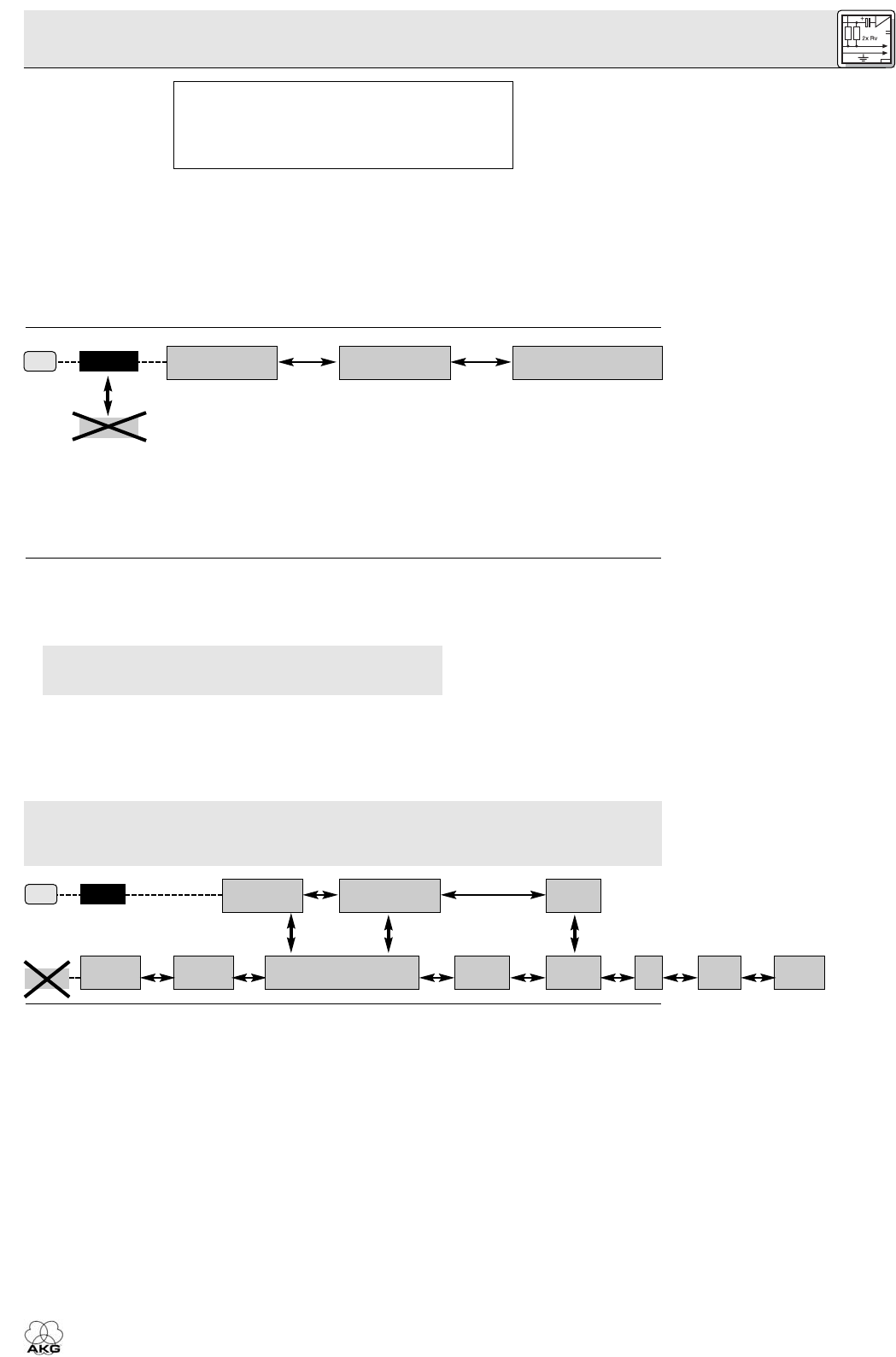
3 Setting Up
3.7 LOCK Mode
Diagram 1: LOCK mode, toggling
between LOCK and SETUP
modes.
3.8 Setting Up the Receiver
(SETUP Mode)
*Note:
Diagram 2: Calling up setup
screens.
If power to the transmitter is OFF or the RF level at the antennas is zero for some other reason (e.g.,
shadow effects), the red RF LED will be lit and the audio output will be muted.
If the antennas receive RF signal, the green RF LED will be lit, the RF bargraph will indicate the field
strength of the signal received by the active antenna, and the Diversity LEDs will indicate which anten-
na is currently active.
The Audio bargraph indicates the audio level of the received signal. The Audio Level LED will flash red
to indicate audio signal clipping.
2. After approximately 5 seconds, the display will change to the last active status screen before power-
ing down.
In LOCK mode, the receiver receives the transmitter signal. The receiver is electronically locked so you
cannot make any adjustments. You may, however, call up the various status screens one after the other.
The "LOCK" label is shown on the display.
•Preset: Carrier frequency shown as Subchannel number within a Frequency Group
•Frequency: Carrier frequency in MHz.
•Name: Current receiver name (comes up only if you have previously named the receiver)
In SETUP mode, the electronic lock is disabled so you can adjust all receiver parameters. The "LOCK"
label is not shown.
The following setup screens are available:
- Auto Group Setup
- Auto Channel Setup for selecting the receiving frequency*
- Preset
- HT 400 handheld transmitter input gain (TX Gain)
- Name
- Infrared data transmission (IR)
- Rehearsal (RHSL)
- Extra (X-TRA)
If your system has only a single channel, we recommend using the Auto Group Setup screen (section
3.8.1) to set the frequency.
To set frequencies for a multichannel system, use the Auto Group Setup and Auto Channel Setup screens
(section 3.8.2).
((Screenshot SR 400))
23
WMS 400
ON Preset
"AT 3.0 02"
Frequenz
"750.000 MHz"
NAME
(nur wenn gespeichert)
LOCK
LOCK
ON Preset
"AT 3.0 02"
Frequenz
"750.000 MHz" (NAME)
TX
Gain (NAME) EXTRAIR
AUTO
GROUP
AUTO
CHANNEL
REHEAR
LOCK
LOCK Preset
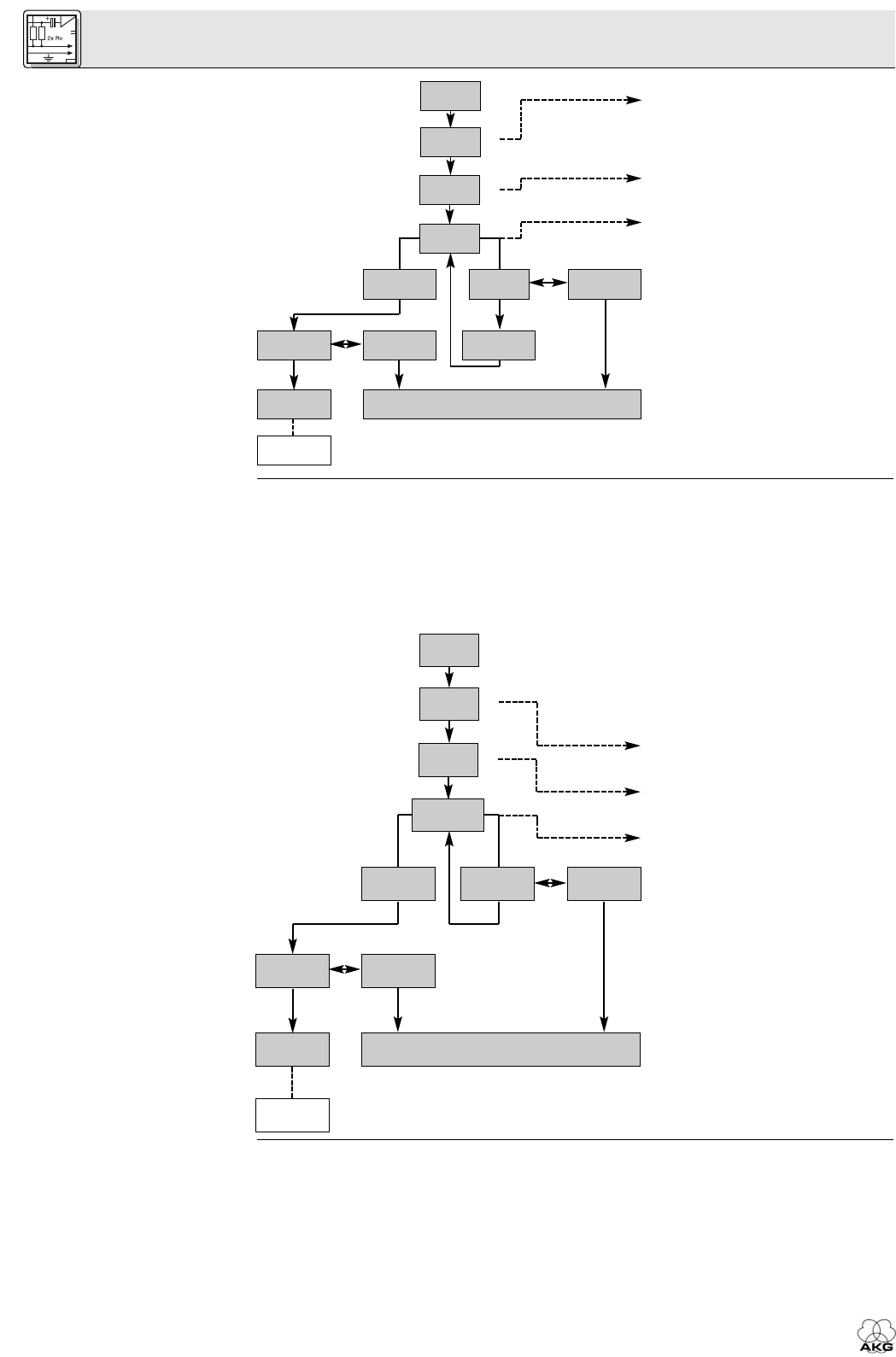
3 Setting Up
3.8.1 Selecting Frequency
Groups (Auto Group Setup)
Diagram 3: Automatic search for a
clean (interference-free) Frequency
Group.
3.8.2 Selecting Frequencies
for Multichannel Systems
(Auto Channel Setup)
>RETRY<: start a new search.
SAVE >Y<: save your setting.
SAVE >N<: reject your setting.
Diagram 4: Automatic search for
clean frequencies for a multichan-
nel system.
Use and to select the number of
required channels between "1" (mini-
mum) for a single-channel system and
"12" (maximum) for a 12-channel system.
Use and to select the desired
Preset. The Preset name is identical to
its country ID code.
The receiver will automatically find a
Group with the selected number of
clean frequencies within the selected
Preset and tune to the first clean fre-
quency.
If the receiver finds no clean frequency,
the display will revert to the previous
Preset name.
>RETRY<: start a new search.
SAVE >Y<: save your setting.
SAVE >N<: reject your setting.
Clean frequencies are frequencies
where the receiver finds no RF signal or
an RF signal whose level is lower than
the current threshold setting.
1. Select the frequency of the first receiver using the Auto Group Setup screen (refer to section 3.8.1
above).
2. Switch ON any radio microphones, personal monitor transmitters, etc. (including even those made by
other manufacturers)! This is the only way to make sure the receiver will find frequencies that will be
free of any mutual interference during the performance.
3. Set all other receivers to the same Preset (NAME) and Frequency GROUP as the first receiver and use
the Auto Channel Setup screen to automatically find the optimum frequency (CHANNEL) for each
receiver:
Use and to select the name of the
target Preset.
Use and to select the target
Frequency Group.
The receiver will automatically find the
next clean frequency.
As soon as the receiver has found a
clean frequency, the Subchannel num-
ber assigned to this frequency will be
displayed.
Clean frequencies are frequencies
where the receiver finds no RF signal or
an RF signal whose level is lower than
the current threshold setting.
24
WMS 400
AUTO GROUP
3.10
>NAME<
"
>AT<"
>RETRY<
>PRG IR<
IR
SAVE >N<
>FREQ<
SAVE >Y<
>FREQ<
>EXIT<
AUTO
GROUP
No CH
>1<
">AT3.001<"
FREQ
>NAME<
"
>AT<"
>NAME<
>SCAN<
AUTO
CHANNEL
AUTO GROUP
SAVE >N<
>FREQ<
SAVE >Y<
>FREQ<
>PRG IR<
IR
3.9
>EXIT<>RETRY<
">AT3.001<"
FREQ
>GROUP<
"
>3.0<"
>CHANNEL<
>SCAN<
>NAME<
"
>AT<"
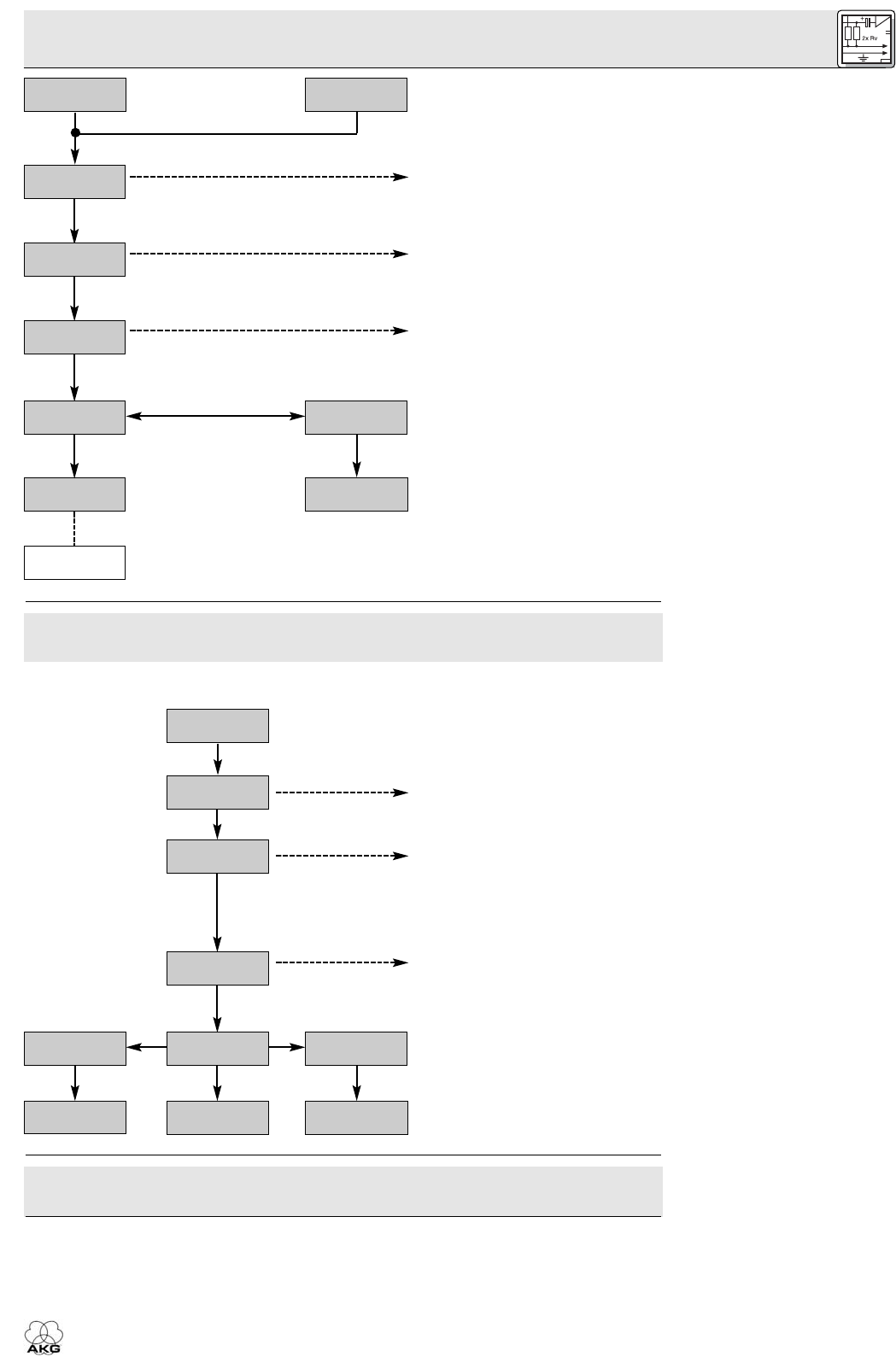
3 Setting Up
3.8.3 Selecting Frequencies
from the Preset Screen
Diagram 5: Setting frequencies
manually.
3.8.4 Editing the Receiver
Name
Note:
Diagram 6: Editing the receiver
name.
3.9 Setting Up the Transmitter
Note:
3.9.1 Frequency
Refer to figs. 3 and 4.
Use and to select the desired
Preset.
Use and to select the desired
Frequency Group.
Use and to select the desired fre-
quency as a Subchannel of the selected
Frequency Group.
SAVE >Y<: save your setting.
SAVE >N<: reject your setting.
This screen lets you edit the current name of the receiver. If you have stored no name for the receiver yet
or deleted its previous name, this screen will not be available. The EXTRA screen, however, allows you
to save a new name at any time (refer to section 4.1.3).
The receiver name may be any combination of up to six letters and/or numbers.
Use and to select the first charac-
ter.
Use and to select the second
character, etc….
… to the sixth character.
SAVE >Y<: save your setting.
SAVE >N<: reject your setting.
>DELETE<: delete all names.
Section 3.9.1 applies to both the HT 400 handheld transmitter and the PT 400 bodypack transmitter. To set
the audio input gain on the HT 400, use the TX Gain screen on the receiver and the infrared connection.
To set the audio input gain on the PT 400, use the gain control in the transmitter battery compartment.
To program the transmitter for the same frequency you selected on the receiver:
1. Switch power to the receiver on.
2. Set the ON-MUTE/PRG-OFF switch (19) on the transmitter to "OFF". The status LED (20) will extin-
guish.
25
WMS 400
"AT 3.0 02"
FREQ
"750.000"
FREQ MHz
Preset
>PRG IR<
IR
>GROUP<
"
>3.0<"
>CHANNEL<
"
>01<"
SAVE >N<
>FREQ<
SAVE >Y<
>FREQ<
>NAME<
"
>AT<"
3.9
NAME
"DIANE"
NAME
"DIANE"
NAME
"
J>I<ANE"
NAME
"
>JONI_ _<"
SAVE >N<
>X-TRA<
EXTRA
X-TRA
>DELETE<
>X-TRA<
SAVE >Y<
>X-TRA<
NAME
"
>D<IANE"
NAME
"
JOANIE"
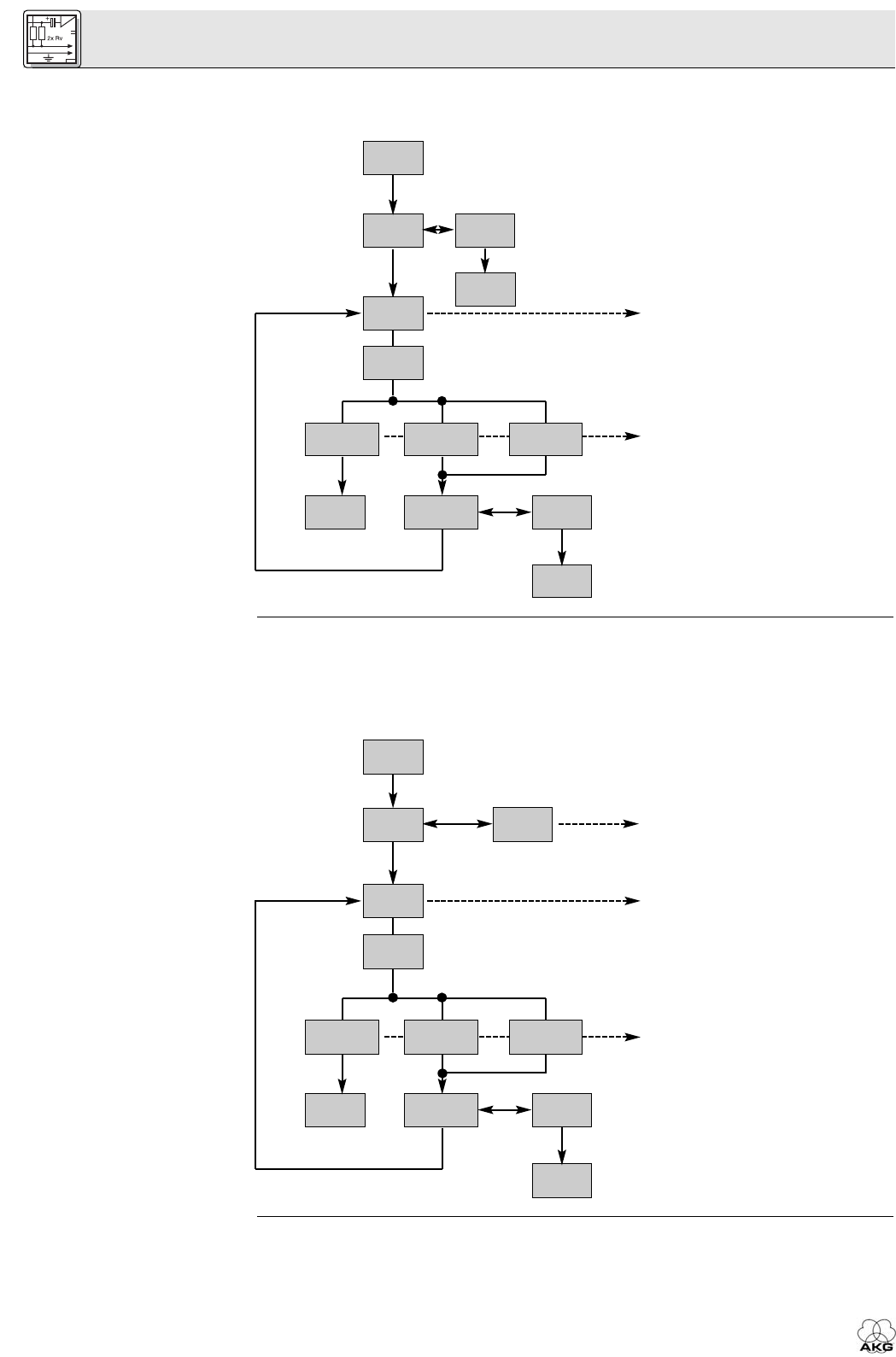
3 Setting Up
Refer to fig. 11.
Diagram 7: Setting the transmitter
carrier frequency.
3.9.2 Handheld Transmitter
Input Gain
Refer to fig. 11.
Diagram 8: Setting the audio input
gain on the handheld transmitter.
3.9.3 Bodypack Transmitter:
Connecting a
Microphone/Instrument and
Setting Input Gain
3. Set the ON-MUTE/PRG-OFF switch (19) to "MUTE/PRG". The display will alternately indicate the cur-
rently selected frequency and "Prg IR". The status LED (20) remains dark.
4. Refer to Diagram 7.
Point the infrared sensor (1) on the
transmitter at the infrared emitter (2) on
the receiver from a distance of 4 inches
(10 cm) max.
IR OK: The transmitter has been tuned
to the same frequency as the receiver.
IR ERR: The data transmission has
failed (no communication).
TXBAND: The frequency bands of the
transmitter and receiver are not identical
or the transmitter RF output is too
high/low.
1. Switch power to the receiver on.
2. Set the ON-MUTE/PRG-OFF switch (19) on the transmitter to "OFF". The status LED (20) will extin-
guish.
3. Set the ON-MUTE/PRG-OFF switch (19) to "MUTE/PRG". The display will alternately indicate the cur-
rently selected frequency and "Prg IR". The status LED (20) remains dark.
4. Refer to Diagram 8.
Select "HI" for a handheld transmitter
with a D 880 dynamic microphone ele-
ment or "LO" for a handheld transmitter
with a C 900 condenser microphone
element.
Point the infrared sensor (1) on the
transmitter at the infrared emitter (2) on
the receiver from a distance of 4 inches
(10 cm) max.
IR OK: The transmitter has been tuned
to the same frequency as the receiver.
IR ERR: The data transmission has
failed (no communication).
TXBAND: The frequency bands of the
transmitter and receiver are not identical
or the transmitter RF output is too
high/low.
The PT 400 bodypack transmitter has been designed primarily for use with "L" type MicroMic Series
microphones from AKG (see section 2.7). If you wish to connect other microphones from AKG or other
manufacturers to the PT 400, please note that you may have to rewire the existing connector of your
microphone or replace it with a 3-pin mini XLR connector.
26
WMS 400
PRG IR
IR
IR
IR
IR
IR
IR
IR
>PRG IR<
IR
>EXIT<
EXITRETRY
IR OK
IR
TXBAND
IR
IR ERR
IR
>TX OFF/
PRG IR<
BUSY
IR
>TXGAIN<
IR
IR
IR
IR
TXG >LO<
EXITRETRY
IR OK
IR
TXBAND
IR
IR ERR
IR
>TX OFF/
PRG IR<
BUSY
IR
TXG >HI<
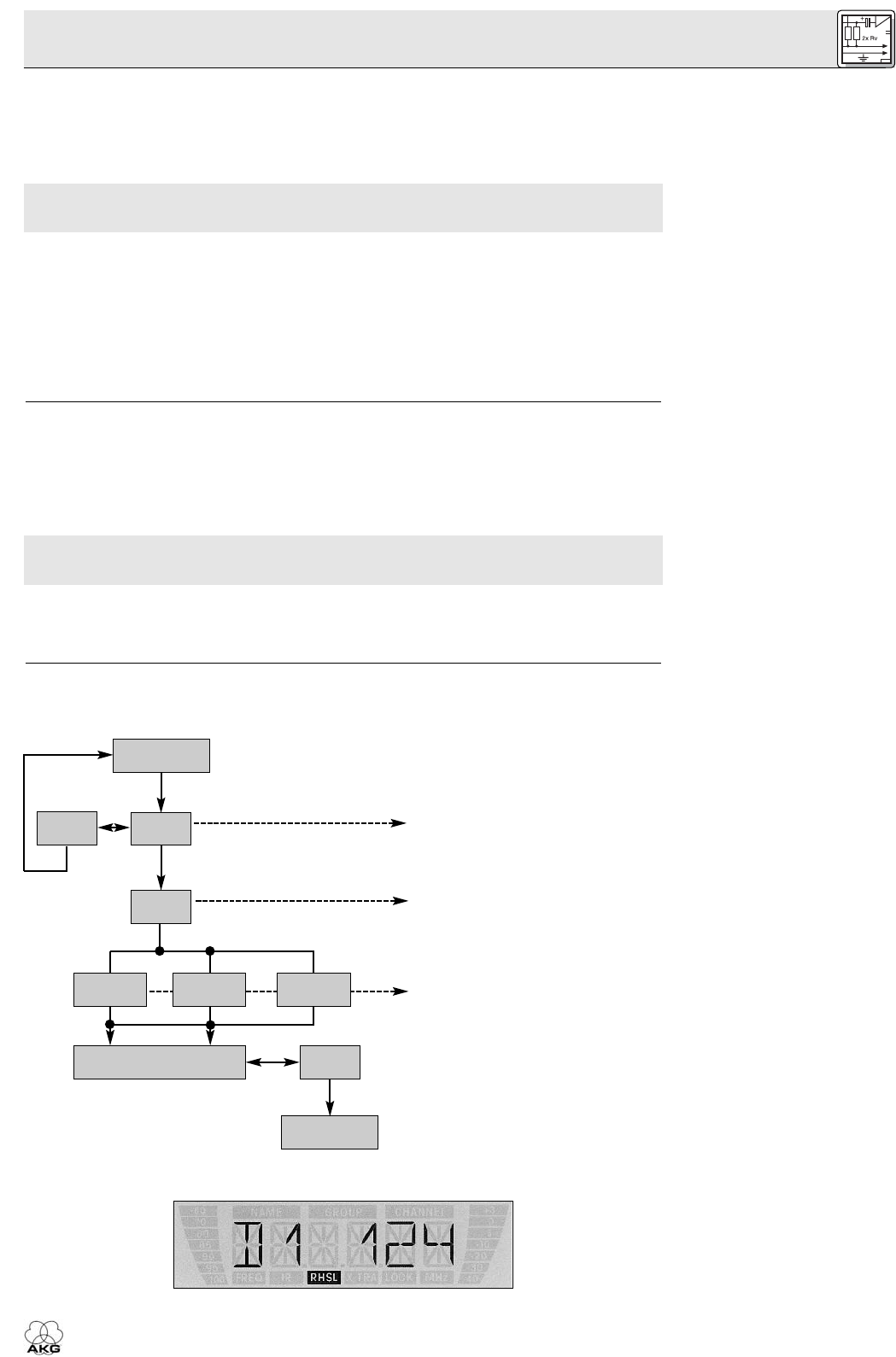
3 Setting Up
Important!
3.10 Before the Soundcheck
Important!
Refer to fig. 1.
3.10.1 Finding Dead Spots
Diagram 9: Using the Rehearsal
function to find dead spots
(dropouts).
Audio input pinout:
Pin 1: shield
Pin 2: audio (inphase)
Pin 3: audio
A positive supply voltage of 6 volts for condenser microphones is available on pin 2.
Please note that AKG cannot guarantee that the PT 400 bodypack transmitter will work perfectly
with products from other manufacturers and any damage that may result from such use is not cov-
ered by the AKG warranty scheme.
1. Plug the mini XLR connector (1) on the cable of your microphone or on the MKG L instrument cable
(2) into the audio input connector (3) on the bodypack transmitter.
2. Set the ON-MUTE/PRG-OFF switch (4) to "ON".
3. Switch power to the receiver on.
4. Open the battery compartment on the bodypack transmitter.
5. Speak or sing into the microphone or play a few bars on your instrument (the louder the better).
6. Use the integrated screwdriver (6) on the battery compartment cover (5) to set the gain control (7) to
the point where the receiver will optimally drive the input to which it is connected. (Also refer to the
manual of your mixer.)
7. Close the battery compartment.
1. Activate the Rehearsal function on the receiver referring to section 3.10.1 below.
2. Move the transmitter around the area where you will use the system to check the area for "dead
spots", i.e., places where the field strength seems to drop and reception deteriorates.
If you find any dead spots, try to eliminate them by repositioning the receiver. If this does not help,
avoid the dead spots.
3. If the received signal is noisy, set the squelch threshold to a level where the noise will stop. (Refer to
section 3.10.2.)
Never set the squelch threshold any higher than absolutely necessary. The higher the squelch
threshold, the lower the sensitivity of the receiver and thus the usable range between transmit-
ter and receiver.
4. The RF bargraph on the receiver extinguishing and the red RF LED (5) coming on mean that no signal
is being received or the squelch is active.
Switch the transmitter ON, move closer to the receiver, or set the squelch threshold to the point that
the green RF LED (5) will illuminate and the RF bargraph reappear.
The Rehearsal function detects a maximum of six dropouts and records the time each dropout occurred,
the minimum field strength at each antenna, and the maximum audio level. You can view the list of results
after the recording has stopped.
Move the transmitter around the area
where you will use the system.
Up to six dropouts are recorded.
You can stop the recording at any time
by pressing o briefly.
D1: The recording has been completed,
the display indicates dropout no. 1.
MIN RF: The recording has been com-
pleted, no dropout has been detected.
The display indicates the minimum RF
level measured.
OVFL: The recording has been stopped
automatically because six dropouts
have been detected already or because
the available time (16 minutes) has
elapsed.
•To retrieve the other results press or briefly. Dropouts are indicated like this (Example 1):
Example 1: Dropout no. 1 occurred after 124 seconds.
27
WMS 400
REHEARSAL
RHSL
REHEARSAL
RHSL
Ergebnisliste
>EXIT<
RHSL
EXIT
"D1 124"
RHSL
OVFL
RHSL
MIN RF
RHSL
>START<
RHSL
RECORD
RHSL
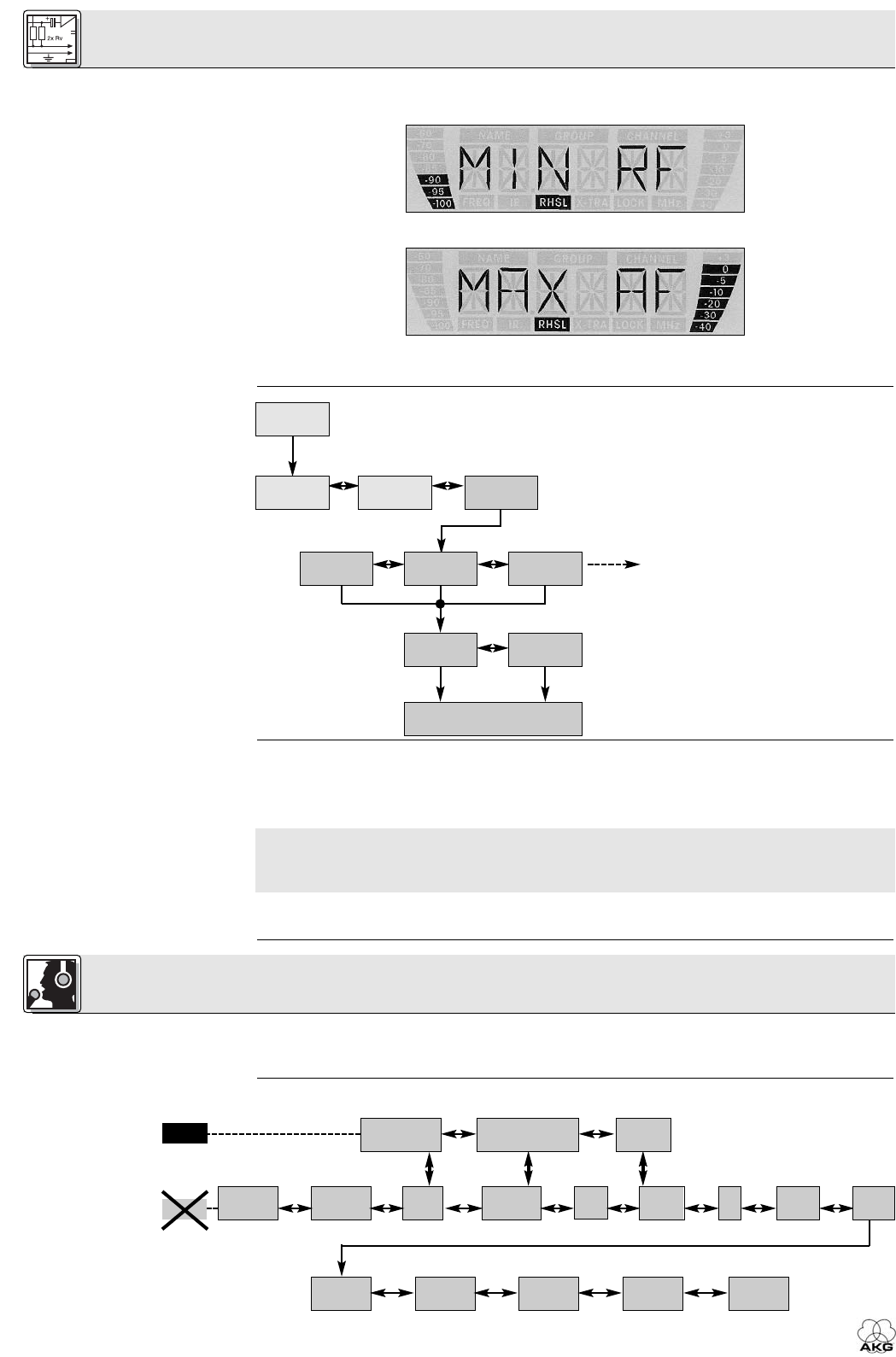
3 Setting Up
3.10.2 Setting the
Squelch Threshold
Diagram 10: Setting the squelch
threshold.
3.11 Multichannel Systems
Note:
4.1 SR 400 Receiver
4.1.1 Selecting Modes
4.1.2 Selecting Screens
LOCK mode:
SETUP mode:
Diagram 11: Selecting screens.
•The first storage locations are assigned to dropouts, the last two for the lowest RF level and highest
audio level measured (Examples 2 and 3).
Example 2: Minimum RF level: -90 dB
Example 3: Maximum audio level: 0 dB
•The last item in the result list is followed (the first item preceded) by the "EXIT" option.
The display indicates the setting cur-
rently in memory, e.g., "-90 dB". Use
and to select one of the following set-
tings: -80, -85, -90, -92, -94, -96, -98, -
100 dB.
Never set the squelch threshold any
higher than absolutely necessary. The
higher the squelch threshold, the lower
the sensitivity of the receiver and thus
the usable range between transmitter
and receiver.
1. Be sure to assign a separate carrier frequency to each wireless channel (transmitter and receiver).
2. To find intermodulation-free carrier frequencies quickly and easily, we recommend using Auto Preset
to select all required carrier frequencies from the same Frequency Group within the same Preset.
If reception on the selected carrier frequency is poor, use Auto Channel Setup (refer to section 3.9.2)
to find the next clean Subchannel within the selected Frequency Group. Should you find no clean
Subchannel, use Auto Group Setup to select a different Frequency Group within the same Preset and
select a new frequency for each WMS 4000 channel (refer to sections 3.9.1 and 3.9.2).
3. Do not operate two or more wireless channels on the same frequency at the same time and location.
This would cause unwanted noise due to radio interference.
To toggle between LOCK and SETUP modes, press and hold the o key for about 1.5 seconds.
When the receiver is in LOCK mode, the "LOCK" label is shown on the display. In SETUP mode, the
"LOCK" label is not shown.
Use and to select the desired status or setup screens.
28
WMS 400
EXTRA
X-TRA
EXTRA
X-TRA
">-80< dB"
X-TRA
">-100< dB"
X-TRA
">-90< dB"
X-TRA
SAVE >Y<
>X-TRA<
SAVE >N<
>X-TRA<
>NAME<
X-TRA
>SQL<
X-TRA
>STATUS<
X-TRA
4 Operating Notes
Preset
"AT 3.0 02"
Frequenz
"750.000 MHz" (NAME)
(NAME)
IR
AUTO
GROUP
AUTO
CHANNEL Preset
>EXIT<>INFO<
TX
GAIN
>SQL<
>STATUS<
>NAME<
Frequenz
REHEAR
LOCK
LOCK
EXTRA
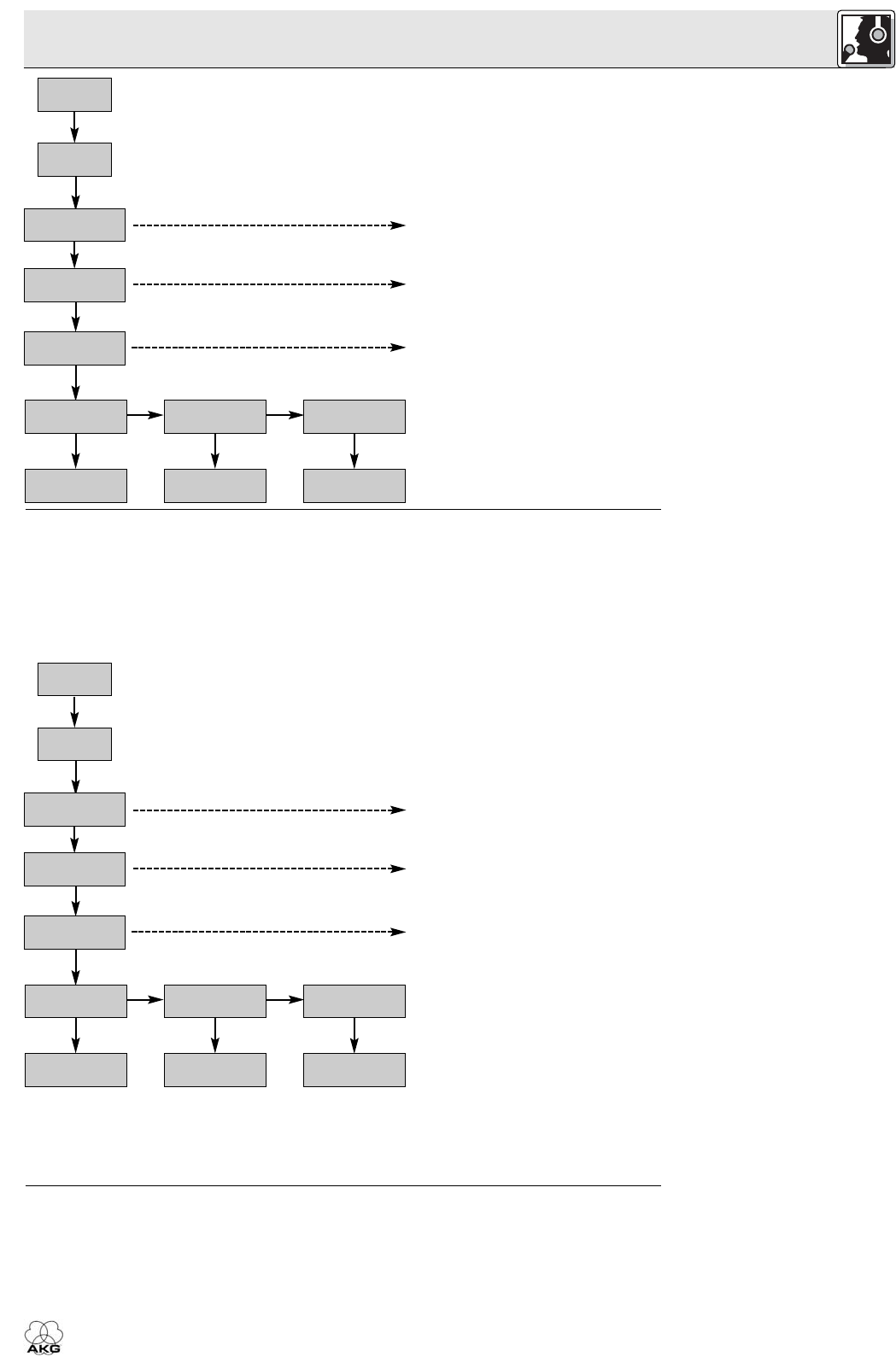
4 Operating Notes
4.1.3 Extra Functions
• NAME
Diagram 12: Entering a new
receiver name.
• STATUS
Diagram 13: Warning messages.
If you have not stored a receiver name
yet, you can use the "NAME" screen to
assign a new name to your receiver.
Use and to select the first charac-
ter.
Use and to select the second
character, etc….
… to the sixth character.
SAVE >Y<: save your setting.
SAVE >N<: reject your setting.
>DELETE<: delete all names.
The "STATUS" screen lets you activate a visual warning that alerts you to selectable critical system con-
ditions. If one of the selected conditions occurs, the display backlighting will change from green to red
and a warning message will appear on the display that describes the current condition. The warning mes-
sages appear in the order of priority:
1. "LOW.BAT": Transmitter battery capacity is low.
2. "AFCLIP": Audio overload.
3. "RF.LOW": Received signal field strength is so low that the receiver audio output has been muted.
- "BAT": The batteries inside the trans-
mitter will be dead in about 60 minutes.
The related message on the display is
"LOW.BAT".
- "AF": The received audio signal drives
the receiver into clipping. The related
message on the display is "AFCLIP".
- "RF": The field strength of the
received RF signal is so low that the
receiver audio output is muted to pre-
vent unwanted noise. The related mes-
sage on the display is "RF LOW".
SAVE >Y<: save your setting.
SAVE >N<: reject your setting.
All selected warning functions are active in both LOCK and SETUP modes. In SETUP mode, however,
the warning functions will be automatically deactivated every time you make an adjustment.
To delete the warning message from the display, press the o key briefly. This will bring up the next warn-
ing message or, if no other critical system conditions were detected, the normal screen. The display
backlighting will revert to green.
29
WMS 400
EXTRA
X-TRA
>NAME<
X-TRA
EXTRA
X-TRA
NAME
"
B>_<"
NAME
"
>BEN_ _ _<"
SAVE >N<
>X-TRA<
EXTRA
X-TRA
>DELETE<
>X-TRA<
SAVE >Y<
>X-TRA<
NAME
>_<
NAME
"
BEN _ _ _"
EXTRA
X-TRA
>NAME<
X-TRA
EXTRA
X-TRA
NAME
"
B>_<"
NAME
"
>BEN_ _ _<"
SAVE >N<
>X-TRA<
EXTRA
X-TRA
>DELETE<
>X-TRA<
SAVE >Y<
>X-TRA<
NAME
>_<
NAME
"
BEN _ _ _"
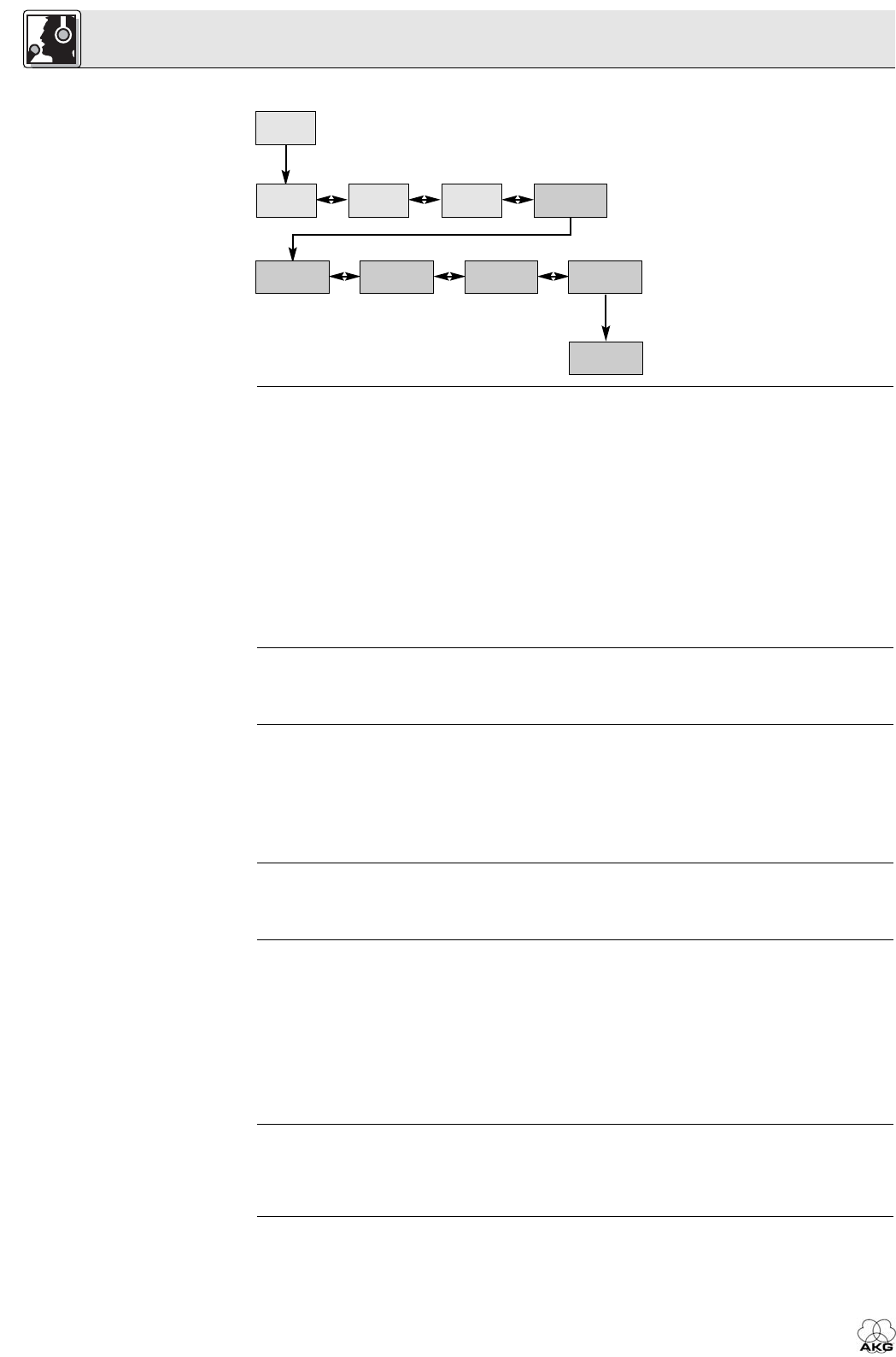
4 Operating Notes
• INFO
Diagram 14: Calling up information
about the receiver.
4.2 HT 400 Handheld
Transmitter
4.2.1 Muting the Microphone
Refer to fig. 3.
4.2.2 Microphone Technique
• Working Distance and
Proximity Effect
Refer to fig. 12.
• Angle of Incidence
Refer to fig. 12.
• Feedback
Refer to fig. 13.
• Backing Choir
Refer to fig. 14.
4.3 PT 400 Bodypack
Transmitter
4.3.1 Muting the Microphone
Refer to fig. 4.
The INFO screen lets you call up information about your receiver.
"V1.1": firmware version
"B 4--.50": frequency band
"PV 1.0": Preset version
1. Set the ON-MUTE/PRG-OFF switch (19) to "MUTE/PRG" (center position).
•If you switched from "OFF" to "MUTE/PRG":
The transmitter audio and RF sections are OFF and the status LED (20) is dark. The infrared receiv-
er section is ON. The transmitter is in setup mode and you can program the carrier frequency and
input gain.
The display indicates the frequency in MHz - frequency in Preset form - "Prg IR" and changes to
alternating between the currently selected Preset and "Prg IR".
•If you switched from "ON" to "MUTE/PRG":
The microphone is muted and the status LED (20) will change from green to red. The infrared
receiver section is OFF. Since the RF section continues transmitting the carrier frequency, no
unwanted noises will become audible form the sound system.
The display alternates between the currently selected Preset and the remaining battery capacity in
hours.
2. To switch the microphone back on, set the ON-MUTE/PRG-OFF switch (19) to "ON".
The status LED (20) will change to green. The display will indicate the remaining battery capacity in
hours.
A handheld vocal microphone provides many ways of shaping the sound of your voice as it is heard over
the sound system.
The following sections contain useful hints on how to use your HT 400 handheld transmitter for best
results.
Basically, your voice will sound the bigger and mellower, the closer you hold the microphone to your lips.
Moving away from the microphone will produce a more reverberant, more distant sound, as the micro-
phone will pick more of the room’s reverberation.
You can use this effect to make your voice sound aggressive, neutral, insinuating, etc. simply by chang-
ing your working distance.
Proximity effect is a more or less dramatic boost of low frequencies that occurs when you sing into the
microphone from less than 2 inches. It gives more "body" to your voice and an intimate, bass-heavy
sound.
Sing to one side of the microphone or above and across the microphone’s top. This provides a well-bal-
anced, natural sound.
If you sing directly into the microphone, it will not only pick up excessive breath noise but also overem-
phasize "sss", "sh", "tch", "p", and "t" sounds.
Feedback is the result of part of the sound projected by a speaker being picked up by a microphone, fed
to the amplifier, and projected again by the speaker. Above a specific volume or "system gain" setting
called the feedback threshold, the signal starts being regenerated indefinitely, making the sound system
howl and the sound engineer desperately dive for the master fader to reduce the volume and stop the
howling.
To increase usable gain before feedback, place the main ("FOH") speakers in front of the microphones
(along the front edge of the stage).
If you use monitor speakers, be sure never to point any microphone directly at the monitors.
Feedback may also be triggered by resonances depending on the acoustics of the room or hall. With res-
onances at low frequencies, proximity effect may cause feedback. In this case, it is often enough to move
away from the microphone a little to stop the feedback.
1. Never let more than two persons share a microphone.
2. Ask your backing vocalists never to sing more than 35 degrees off the microphone axis.
The microphone is very insensitive to off-axis sounds. If the two vocalists were to sing into the micro-
phone from a wider angle than 35 degrees, you may end up bringing up the fader of the microphone
channel far enough to create a feedback problem.
1. Set the ON-MUTE/PRG-OFF switch (19) to "MUTE/PRG" (center position).
•If you switched from "OFF" to "MUTE/PRG":
The transmitter audio and RF sections are OFF and the status LED (20) is dark. The infrared receiv-
er section is ON. The transmitter is in setup mode and you can program the carrier frequency.
30
WMS 400
EXTRA
X-TRA
EXTRA
X-TRA
"V 1.1"
X-TRA
"PV 1.0"
X-TRA
EXIT
X-TRA
"B 4--.50"
X-TRA
>NAME<
X-TRA
>INFO<
X-TRA
>STATUS<
X-TRA
>SQL<
X-TRA

4 Operating Notes
• Optional Remote Mute
Switch
Refer to fig. 14.
4.3.2 Locking the
ON-MUTE/PRG-OFF Switch
Refer to fig. 14.
4.3.3 Microphone Technique
• C 417 L, CK 55 L Lavalier
Microphones
• C 420 L, C 444 L Head-worn
Microphones
The display indicates the frequency in MHz - frequency in Preset form - "Prg IR" and changes to
alternating between the currently selected Preset and "Prg IR".
•If you switched from "ON" to "MUTE/PRG":
The microphone is muted and the status LED (20) will change from green to red. The infrared
receiver section is OFF. Since the RF section continues transmitting the carrier frequency, no
unwanted noises will become audible form the sound system.
The display alternates between the currently selected Preset and the remaining battery capacity in
hours.
2. To switch the microphone back on, set the ON-MUTE/PRG-OFF switch (19) to "ON".
The status LED (20) will change to green. The display will indicate the remaining battery capacity in
hours.
The optional Remote Mute Switch allows you to mute the transmitter if it is mounted in a position where
it is difficult or impossible to use the "on-board" MUTE switch.
1. Plug the cable (1) on the Remote Mute Switch into the REMOTE MUTE jack (2) on the transmitter.
2. Put the Remote Mute Switch in a jacket or shirt pocket or use the belt clip to clamp the Remote Mute
Switch on the belt.
3. To mute the microphone, press the button on the Remote Mute Switch. The button will lock and the
status LED will change to red.
4. To switch the microphone back on, press the button again. The status LED will change to green.
1. Plug the supplied terminal connector (3) into the REMOTE MUTE jack (2) on the bodypack transmit-
ter.
The ON-MUTE/PRG-OFF switch on the bodypack transmitter is electronically locked. You can not
mute the microphone unintentionally.
2. To unlock the ON-MUTE/PRG-OFF switch, disconnect the terminal connector (3) from the REMOTE
MUTE jack (2).
1. Fix the microphone to the H 40/1 lavalier clip or H 41/1 tiepin referring to the microphone’s instruction
manual.
2. Clamp the microphone on your clothing as close as possible to your mouth.
Remember that gain-before-feedback will be the higher the smaller the distance between the micro-
phone and the mouth!
3. Make sure to aim the microphone at your mouth.
Refer to the user’s manual of the respective microphone for instructions on how to use head-worn micro-
phones.
To clean the transmitter and receiver surfaces, use a soft cloth moistened with water.
31
WMS 400
5 Cleaning

32
6 Troubleshooting
WMS 400
Problem
No sound.
Noise, crackling, unwanted signals.
Distortion.
Momentary loss of sound ("dropouts") at
some points within performance area.
Receiver Error Message
ERR.>SYS<
ERR.>USR<
ERR.>PRE<
ERR.>RF<
Possible Cause
1. AC adapter is not connected to receiver
and/or power outlet.
2. Receiver is OFF.
3. Receiver is not connected to mixer or
amplifier.
4. Microphone or instrument is not connected
to bodypack transmitter.
5. Transmitter is tuned to different frequency
than receiver.
6. Transmitter is "OFF" or transmitter MUTE
switch at "MUTE".
7. Transmitter batteries are not inserted
properly.
8. Transmitter batteries/battery pack dead.
9. Transmitter is too far away from receiver or
squelch threshold setting is too high.
10.Obstructions between transmitter and
receiver.
11.Receiver is invisible from transmitter location.
12.Receiver too close to metal objects.
13.Transmitter and receiver Preset versions
are not identical.
1. Antenna location.
2. Interference from other wireless systems,
TV, radio, CB radios, or defective electrical
appliances or installations.
1. GAIN control on transmitter is set too high
or too low.
2. Interference from other wireless systems,
TV, radio, CB radios, or defective electrical
appliances or installations.
•Antenna location.
Problem
Frequency settings cannot be changed.
Last setting cannot be loaded.
Error in selected Preset.
PLL error. (Receiver cannot lock on to select-
ed frequency.)
Remedy
1. Connect AC adapter to receiver and/or
power outlet.
2. Push POWER switch to switch receiver ON.
3. Connect receiver output to mixer or ampli-
fier input.
4. Connect microphone or instrument to
audio input on bodypack.
5. Tune transmitter and receiver to the same
frequency.
6. Switch transmitter "ON" or set MUTE
switch to ”ON” position.
7. Insert batteries conforming to "+" and "-"
marks.
8. Replace batteries/charge battery pack.
9. Move closer to receiver or choose lower
squelch threshold setting.
10.Remove obstructions.
11.Avoid spots where you cannot see receiver.
12.Remove offending objects or move receiv-
er away.
13.Check Preset versions on transmitter and
receiver.
1. Relocate receiver or antennas.
2. Switch off interference sources or defective
appliances or tune transmitter and receiver
to a different frequency; have electrical
installation checked.
1. Decrease or increase GAIN setting just
enough to stop the distortion.
2. Switch off interference sources or defective
appliances or tune transmitter and receiver
to a different frequency; have electrical
installation checked.
•Relocate receiver or antennas. If dead
spots persist, mark and avoid them.
Remedy
1. Switch power to receiver OFF and back
ON after about 10 seconds.
2. If problem persists, contact your AKG
Service Center.
1. Set frequency and squelch threshold again.
2. If problem occurs frequently, contact your
AKG Service Center.
1. Continue with previous Preset.
2. Select error-free Preset.
3. If problem occurs frequently, contact your
AKG Service Center.
1. Set different frequency.
2. If problem persists, contact your AKG
Service Center.

33
7 Specifications
SR 400
RF carrier frequency ranges: 650 to 680, 680 to 710, 720 to 750, 760 to 790, 790 to 820, 835 to 863 MHz
Modulation: FM
Audio bandwidth: 35 to 20,000 Hz
THD at 1 kHz: <0.3%
Signal-to-noise: 120 dB(A)
Audio outputs: balanced XLR and unbalanced TS 1/4" jack, balanced level switchable to -30 or 0 dBm
Dimensions: 200 x 44 x 190 mm (7.8 x 1.7 x 7.4 in.)
Weight: 972 g (2.2 lbs.)
HT 400
Carrier frequency ranges: 650 – 680, 680 – 710, 720 – 750, 760 – 790, 790 – 820, 835 - 863 MHz
Modulation: FM
Audio bandwidth: 35 to 20,000 Hz
THD: <0.7% typical at rated deviation/1 kHz
S/N Ratio (A-weighted) 120 dB(A)
RF output: 50 mW max. (ERP)
Battery life: 1.5 V AA size dry battery: 6 hours; 1.2 V NiMH, 2100 mAh AA size rechargeable battery: 8 hrs.
Size: 229 x 52.5 mm max. dia. (9 x 2 in.)
Net Weight: 220 g (7.8 oz.)
PT 400
Carrier frequency ranges: 650 – 680, 680 – 710, 720 – 750, 760 – 790, 790 – 820, 835 – 863 MHz
Modulation: FM
Audio bandwidth: 35 to 20,000 Hz
THD: <0.7% typical at rated deviation/1 kHz
S/N ratio (A-weighted) 120 dB(A) typical
RF output: 50 mW max. (ERP)
Battery life: 1.5 V AA size dry battery: 6 hours; 1.2 V NiMH, 2100 mAh AA size rechargeable battery: 8 hrs.
Size: 60 x 73,5 x 30 mm (2.4 x 2.9 x 1.2 in.)
Net weight: 90 g (3.2 oz.)
This product conforms to the standards listed in the Declaration of Conformity.
WMS 400